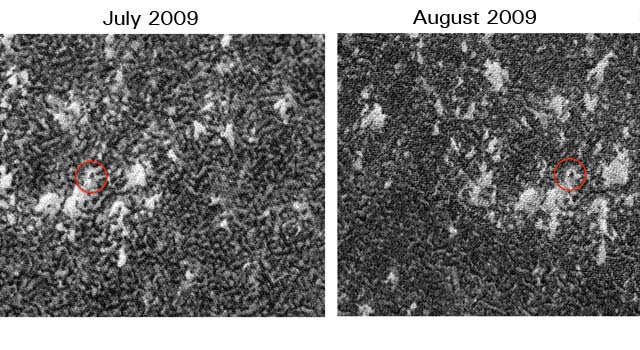Frost-Covered Mars Lander Photographed From Above

The long-defunct Phoenix Lander is covered in frost on the frozen Martian wasteland, as seen in new images taken from orbit.
The NASA lander stopped communicating a year ago after its successful mission.
The new images, taken a few weeks ago and released Wednesday, show the lander shrouded in frost made of carbon dioxide, what we call dry ice. It is barely distinguishable from the desolate winter landscape.
The images were taken with the HiRISE camera on the space agency's Mars Reconnaissance Orbiter on July 30 and Aug. 22, when the sun began peeking over the horizon of the northern polar plains during winter. The first day of spring in the northern hemisphere began Oct. 26.
"We decided to try imaging the site despite the low light levels," said HiRISE team member Ingrid Spitale of the University of Arizona Lunar and Planetary Laboratory.
The HiRISE (High Resolution Imaging Science Experiment) team targeted their camera at the known location of the lander to get the new images and compared them to a HiRISE image of the frost-free lander taken in June 2008. That enabled them to identify the hardware disguised by frost, despite the fact that their views were hindered by poor lighting and by atmospheric haze, which often obscures the surface at this location and season.
Carbon dioxide frost completely blankets the surface in both images. The amount of carbon dioxide frost builds as late winter transitions to early spring, so the layer of frost is thicker in the Aug. 22 image.
Breaking space news, the latest updates on rocket launches, skywatching events and more!
Brightness doesn't necessarily indicate the amount of frost seen in the images because of the way the images are processed to produce optimal contrast. Even the darker areas in the frost-covered images are still brighter than typical soil that surrounds the lander in frost-free images taken during the lander's prime mission in 2008.
Other factors that affect the relative brightness include the size of the individual grains of carbon dioxide ice, the amount of dust mixed with the ice, the amount of sunlight hitting the surface and different lighting angles and slopes, scientists said.
Studying these changes will help us understand the nature of the seasonal frost and winter weather patterns in this area of Mars.
During the first quarter of 2010, teams at NASA's Jet Propulsion Laboratory will listen to see if Phoenix is still able to communicate with Earth. Communication is not expected and is considered highly unlikely following the extended period of frost on the lander.
- Images: Phoenix on Mars
- Phoenix Mars Lander Found Liquid Water, Some Scientists Think
- Mars News & Information

Space.com is the premier source of space exploration, innovation and astronomy news, chronicling (and celebrating) humanity's ongoing expansion across the final frontier. Originally founded in 1999, Space.com is, and always has been, the passion of writers and editors who are space fans and also trained journalists. Our current news team consists of Editor-in-Chief Tariq Malik; Editor Hanneke Weitering, Senior Space Writer Mike Wall; Senior Writer Meghan Bartels; Senior Writer Chelsea Gohd, Senior Writer Tereza Pultarova and Staff Writer Alexander Cox, focusing on e-commerce. Senior Producer Steve Spaleta oversees our space videos, with Diana Whitcroft as our Social Media Editor.
